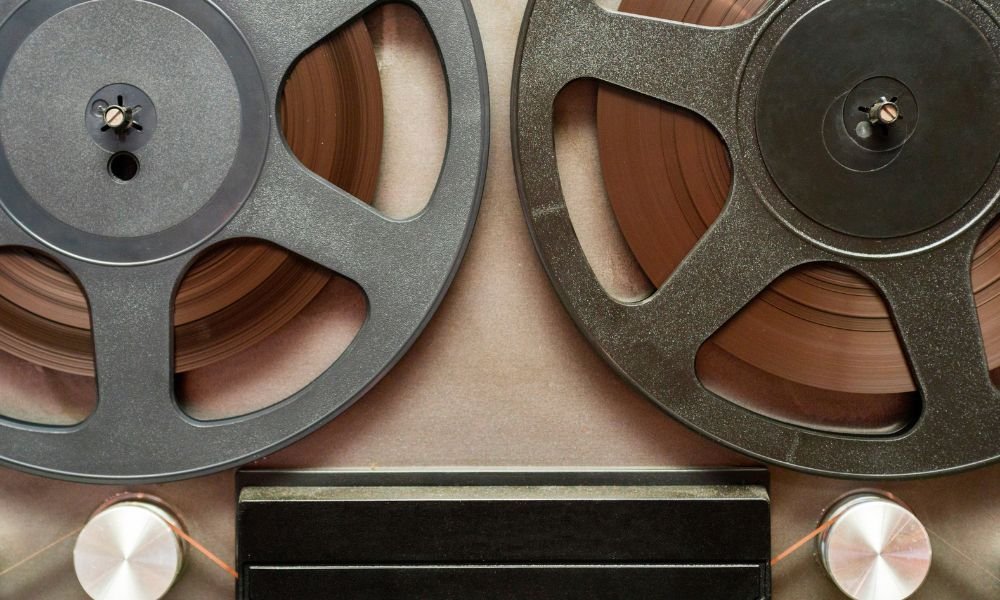Unwinding the History of Reel-to-Reel Tape Recording
Before digital streaming, CDs, cassette tapes, or even vinyl records, there was reel-to-reel tape recording. But how did reel-to-reel recording come about?
We’ll answer that question and more in our unwinding of the history of reel-to-reel tape recording from its humble origins in Copenhagen to its modern-day revival!
Origins of Reel-to-Reel Audio Recording
Reel-to-Reel (R2R) tape recording has a fascinating history filled with unique characters and curious coincidences. To accurately explain the origins of R2R audio recording, we must travel back to the 19th century to learn about the inventors who laid the foundation for the R2R tape recorder.
Valdemar Poulsen’s Piano Wire
In the 1890s, Dutch technician Valdemar Poulsen was working at the Copenhagen Telephone Company when he became interested in the possibility of the magnetic recording of sound. An inventor and tinkerer, Poulsen came up with an experiment in which he stretched a piano wire across the room at an angle and let an electromagnet slide down the wire.
Poulsen attached a battery-operated microphone to the electromagnet to record the sound. He then replaced the battery and microphone with a phone earpiece and placed the electromagnet at the top of the wire to repeat the experiment and determine whether he could hear the captured sound.
The experiment was successful, and Poulsen proved that one could record sound using magnetic properties. He continued this work and in 1900, at the World Exposition in Paris, demonstrated his new telegraphone by recording the voice of Emperor Franz Joseph of Austria.
J.A. O’Neill’s Magnetic Ribbon
Almost three decades later, an American improved upon Poulsen’s invention by replacing the steel wire with a magnetically coated ribbon; this ribbon is considered the first form of magnetic tape.
Fun Fact: Magnetic tape is still used in audio recording nearly a century later due to the advancements made by J.A. O’Neill.
Marvin Camras’ Contributions
The next advancement in magnetic audio recording came from another American—Marvin Camras. While studying electrical engineering at college in the 1930s, Camras was trying to help his cousin, an aspiring opera singer.
Camras first used Poulsen’s patented piano wire technique, but the quality was distorted and not helpful. Camras tinkered with the technique and came up with a solution—a magnetic recording head that would encircle the wire without touching it.
The sound was much better and clearer, and Camras patented his idea to great acclaim. The US Navy and Army used it to train submarine pilots and invent decoy attacks, respectively. Soon after his patent, Camras continued experimenting and eventually came up with a ferric oxide paint, making magnetic tape the ideal surface for audio recording.
Fun Fact: Camras’ cousin gave up singing professionally after hearing his voice on Camras’ new recording device.
The Invention of the Magnetophon
While Americans like O’Neill and Camras were tinkering with Poulsen’s magnetic audio recording idea, impressive advancements were also happening across the pond in Germany. In 1934, the German division of General Electric came up with the first commercial tape recorder: the Magnetophon.
Incredibly enough, we still don’t know the engineers who came up with the advancement that changed the world and communications as we know it! Although German radio professionals knew about it, the Magnetophon was a secret that wouldn’t become known to the West until one American soldier’s discovery during World War II.
John T. Mullin’s Musical Discovery
In 1944, John T. Mullin was stationed in London with the US Army Signal Corps and Royal Air Force when late one night, he heard a radio playing a Beethoven symphony performed by the Berlin Philharmonic. Mullin was astounded by the sound quality, and since it was so late, he knew it couldn’t be a live show. This moment changed everything he thought was possible in audio recording.
After the war, the Army Signal Corps assigned Mullin to a special division in Paris with a priority of discovering the apparent communications advancements German engineers had made. Primarily by chance and rumor, Mullin wound up at a radio station in Frankfurt, where he set his eyes on the famed Magnetophon he’d heard years before.
Mullin Debuts His Discovery
After finding the elusive Magnetophon, Mullin took two devices back to the US and mailed himself 50 reels of tape. He spent months fine-tuning the machine until he debuted his results to an audience of professional radio engineers.
With his witnesses in place, Mullin played a live radio show of a jazz concert, then switched to a tape recording from the Magnetophon of the same concert and questioned the audience which was which. The stunned engineers couldn’t tell the difference, astounded by the sound quality of the recording.
Bing Crosby and Ampex Development
Oddly enough, one of the biggest developments of R2R audio recording in America in the 1950s is due to famous singer Bing Crosby. Crosby hated live radio shows and believed the standard wax records were subpar.
Crosby and his sound engineers heard about Mullin, so they immediately hired him; they paired Mullin with the company Ampex, which produced radar technology for the military during the war but needed a new product. They immediately got to work improving magnetic tape-recording technology and soon came out with their first industry-changing invention.
Rise of the Ampex Tape Recorder
In 1948, Ampex debuted its first tape recorder: the Ampex Model 200. It was breakthrough technology that fostered the beginning of the R2R era in audio recording. Soon, orders came from ABC and other broadcasters across the country.
Ampex became the standard in the industry, and its tape recorders were pervasive in all forms of audio recording. Approximately eight years later, they released the Ampex Mark IV, which was much smaller for recording video and cemented Ampex as the leader in broadcast recording for video and audio.
Fun Fact: The Ampex Model 200 was massive and cost nearly as much as a down payment on a house at that time.
The Reel-to-Reel Era
More companies and tape recorders emerged in the following years, but the R2R audio recording technology was ubiquitous for decades. Advancements in R2R recording later included direct drive motors and solid state circuits as the models became more user-friendly and affordable for everyday people.
It wasn’t until the rise of the cassette tape that the R2R tape fell out of favor.
The Decline of Reel-to-Reel Tape
Although Phillips invented the cassette tape deck in the early 1960s, it didn’t become the predominant form of tape recording until the 1970s. Once cassettes took over, consumers had little need for the larger, more intricate R2R tape recorder.
By the 1980s, almost all manufacturers had discontinued their R2R recorders and tape production. The advent of CDs and digital technology was considered the final nail in the coffin of R2R tape recording.
The Analog Revival
In the past decade, the audio industry has undergone what some are referring to as the “analog revival.” Once thought dead due to digital technology, vinyl records, cassette tapes, and CDs have come back as consumers crave the distinct sounds provided by physical media.
Even in the decades since it first came on the scene, R2R tape recordings are still considered by professionals and audiophiles as the cream of the crop. R2R recorders and tapes are now prized commodities for collectors and professionals, as few of the devices are left.
We hope you’ve enjoyed unwinding the history of reel-to-reel tape recording and that you learned something interesting! If you have an old R2R tape recorder somewhere, be sure to take care of it.
Old tapes are notoriously fragile and delicate—consider using a reel-to-reel transfer service to convert the audio to digital, minimizing the chance of losing the audio forever. If you’ve got questions about reel-to-reel recorders, tape, or transfers, don’t hesitate to consult with the experts at DiJiFi!


